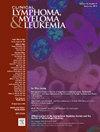Plasma Cytokine and Chemokine Profiles Predict Efficacy and Toxicity of Anti-CD19 CAR-T Cell Therapy in Large B-Cell Lymphoma
IF 2.7
4区 医学
Q2 HEMATOLOGY
引用次数: 0
Abstract
Background
Anti-CD19 chimeric antigen receptor T-cell (CAR-T) therapy has emerged as a promising treatment for large B-cell lymphoma (LBCL); however, durable complete responses are achieved in only 30% to 40% of patients. Additionally, CAR-T therapy is frequently associated with significant toxicities, including cytokine release syndrome (CRS) and immune effector cell-associated neurotoxicity syndrome (ICANS).
Patients and Methods
We explored the translational potential of cytokines and chemokines as predictive biomarkers for CAR-T outcomes by analyzing 47 plasma cytokines/chemokines in serial blood samples from 24 LBCL patients undergoing CAR-T therapy. Blood samples were collected at multiple times: prelymphodepletion, day of CAR-T infusion (Day 0), and post-infusion. We investigated the association between cytokine levels and key clinical outcomes using machine learning models, including treatment response at 3 months, CRS, and ICANS.
Results
Higher day 0 IL-7, day 7 IL-21, and day 0 CCL8 levels correlated with improved remission rates. Conversely, elevated CRS risk was linked to higher day 0 CCL17 and day 3 CCL13, IL-6, and IFN-γ levels. ICANS development was associated with increased day 0 TGF-β1, and day 3 IL-5 and IL-7 levels, while lower day 0 CCL19 and day 3 VIP levels were inversely related to ICANS risk. Additionally, patients who received higher-intensity lymphodepletion had elevated day 0 CCL2 and IL-15 levels.
Conclusion
These findings highlight the role of plasma cytokines and chemokines as biomarkers for predicting both the therapeutic efficacy and toxicity of CART, with the potential to guide more personalized, safer, and effective immunotherapies for B cell lymphoma.
血浆细胞因子和趋化因子谱预测抗cd19 CAR-T细胞治疗大b细胞淋巴瘤的疗效和毒性。
背景:抗CD19嵌合抗原受体T细胞(CAR-T)疗法已成为治疗大B细胞淋巴瘤(LBCL)的一种前景看好的疗法;然而,只有30%至40%的患者能获得持久的完全应答。此外,CAR-T疗法经常伴有明显的毒性,包括细胞因子释放综合征(CRS)和免疫效应细胞相关神经毒性综合征(ICANS):我们通过分析 24 名接受 CAR-T 疗法的 LBCL 患者连续血样中的 47 种血浆细胞因子/趋化因子,探讨了细胞因子和趋化因子作为 CAR-T 结果预测生物标志物的转化潜力。血液样本在多个时间段采集:淋巴消耗前、CAR-T 输注当天(第 0 天)和输注后。我们使用机器学习模型研究了细胞因子水平与主要临床结果之间的关联,包括3个月的治疗反应、CRS和ICANS:结果:较高的第 0 天 IL-7、第 7 天 IL-21 和第 0 天 CCL8 水平与较高的缓解率相关。相反,CRS 风险升高与第 0 天 CCL17 和第 3 天 CCL13、IL-6 和 IFN-γ 水平升高有关。ICANS的发生与第0天TGF-β1、第3天IL-5和IL-7水平的升高有关,而较低的第0天CCL19和第3天VIP水平与ICANS风险成反比。此外,接受高强度淋巴清扫的患者第0天CCL2和IL-15水平升高:这些发现凸显了血浆细胞因子和趋化因子作为生物标志物在预测CART疗效和毒性方面的作用,有望为B细胞淋巴瘤提供更个性化、更安全、更有效的免疫疗法。
本文章由计算机程序翻译,如有差异,请以英文原文为准。
求助全文
约1分钟内获得全文
求助全文
来源期刊

Clinical Lymphoma, Myeloma & Leukemia
ONCOLOGY-HEMATOLOGY
CiteScore
2.70
自引率
3.70%
发文量
1606
审稿时长
26 days
期刊介绍:
Clinical Lymphoma, Myeloma & Leukemia is a peer-reviewed monthly journal that publishes original articles describing various aspects of clinical and translational research of lymphoma, myeloma and leukemia. Clinical Lymphoma, Myeloma & Leukemia is devoted to articles on detection, diagnosis, prevention, and treatment of lymphoma, myeloma, leukemia and related disorders including macroglobulinemia, amyloidosis, and plasma-cell dyscrasias. The main emphasis is on recent scientific developments in all areas related to lymphoma, myeloma and leukemia. Specific areas of interest include clinical research and mechanistic approaches; drug sensitivity and resistance; gene and antisense therapy; pathology, markers, and prognostic indicators; chemoprevention strategies; multimodality therapy; and integration of various approaches.
 求助内容:
求助内容: 应助结果提醒方式:
应助结果提醒方式:


